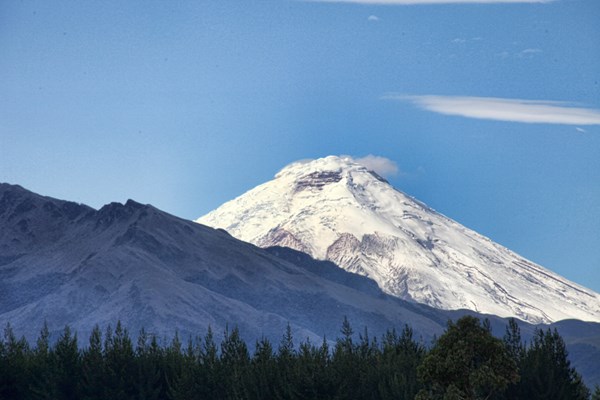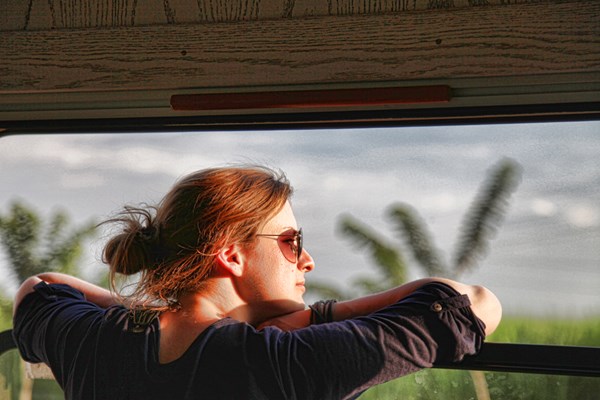QUITO, Ecuador, Aug. 14, 2013 (GLOBE NEWSWIRE) -- Posicionarte, a travel media agency, was invited to discover the brand new Ecuador´s cruise train trip 4 days 3 nights from the Andes to Coast, it´s travel editor Andrew Taylor, travelling by train through the volcanic Ecuadorian Andes explains why Ecuador rocks!
It's an epic moment on our voyage. We are cruising up the centre reservation of San Raphael high street in a shiny, red luxury locomotive. There are scooters patrolling us at our side, the traffic has halted, horns are hooting, sirens are wailing, shoppers are cheering, waving, smiling and pointing, lifting up their children to see this extraordinary vision.
Andrew begins telling his journey: "I am at the back of the train on the open air shaded viewing terrace, and if I happen to be soaking up all this glory as if it was meant for me personally, who´s going to know the difference? When you´ve had enough of my make-believe Messianic moment, why not come inside and I'll show you around the wagons...".
There are two dining wagons designed in colonial and republican style respectively, two very comfortable lounge areas with sofas and cushions (one representing the highlands, the other the coast.) There's a bar, spotless washroom facilities and a steady flow of nibbles, refreshments and hot or cold flannels brought round on silver trays.
"I love Ferrocarrile's Tren Crucero product" Andrew continues,"It's emblematic, retro and super-comfortable."
The train line itself is of exceptional importance to the nation. Back in the late 1800s, having (finally) booted out the Spanish and claimed independence, Ecuador had a major infrastructure challenge. Between the highlands and the coast, there was a simple donkey path through cloud forests. Risking exposure to malaria, snake bites and bandits, it is said that few people survived the three week hike.
The train took over fifty years to construct and covers a distance of over 400km, linking the two largest cities: Quito, the highland capital and Guayaquil, the largest city in Ecuador on the Pacific coast.
The train expanded trade within the country and improved the quality of life no end. Glacial ice from the volcanoes could be brought to the coast for refrigeration and fish and coastal fruits could get to the highlanders. Historically, for Ecuador the train line was (and remains) the Pride of the Nation.
Its development continued and survived different political ideologies and natural disasters. Thousands of workers lost their lives in its making. The engineers met their greatest nemesis in 1901. The Devil´s Nose, a 45 degree precipice was an unprecedented challenge and today remains the world´s most difficult train passage.
For this new nation, the train represented hope and became an emblem of tenacious progress against adversity.
Ecuador has a great deal to be proud of. Within this relatively new nation there are a number of indigenous nations including the Shuar, Cofan, Huarani, Tsachila, Cañari, Otavalo and Panzaleo people. 80% of rural (mostly indigenous) population live in absolute poverty and indigenous farmers produce 75% of the nation´s basic foods.
Ecuador boasts four distinct tourist destinations, each deserving a quality of attention: The Galapagos Islands, the Amazon basin and rainforests, the Andean Sierra and the Pacific coast. You can climb volcanoes, watch whales, visit jungle lodges, scuba dive, bird watch, ride horses and enjoy its stunning variety of bird life.
The scenic train ride provides a taste of the variety of Ecuadorian culture. In a four day trip you visit a rose plantation, an Incan chapel, Cotopaxi volcano, a glacial lake, a highland indigenous market and a Shuar tribe. The train passes through paramos and nevados from Quito (at 2777m) to the highest altitude station of El Boliche at 3547m. As you move deeper into the Andes, the population is 60% indigenous, the Quechua de la Sierra people and from a big red train your treated to a display of agriculture at its most simple – women carrying huge bags of feed, people ploughing and tending small fields of crops – alfalfa, onions, corn, quinoa and pumpkins.
The Tren Crucero Excursion is a confidently engineered experience. The onboard team are really personable, educated and experienced. They each have their own special knowledge depending on their ancestry and personal interests. The service is first class, and the trip is a thrill. The overnight stays are a real adventure. Andrew says he liked La Cienega (34 rooms of rather eerie Andean luxury). Abraspungo had the most generous and comfortable beds and stylish en suite bathrooms. There are 42 rooms and they all come with under floor heating.) Eterna Primavera (Eternal Spring) (with 37 rooms) offered more modest accommodation, but the salsa around the pool and the croon singer were hilarious. Until New Years Eve 2013 the trip is $990 all inclusive: http://www.ecuadorbytrain.com/trainecuador/crucero/web/ecuador-train">http://www.ecuadorbytrain.com/trainecuador/crucero/web/ecuador-train
Photos accompanying this release are available at:

